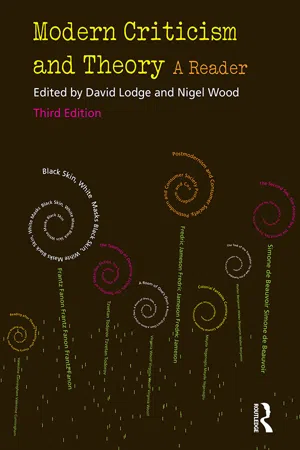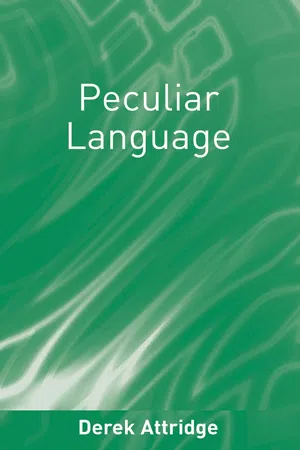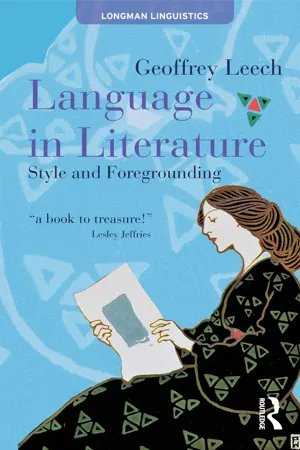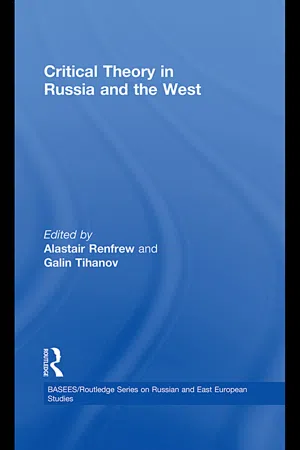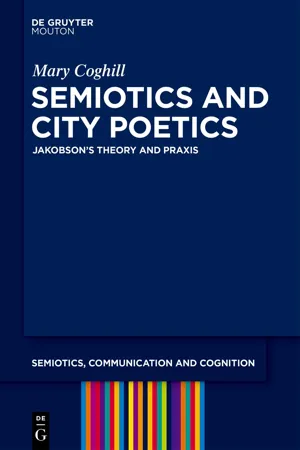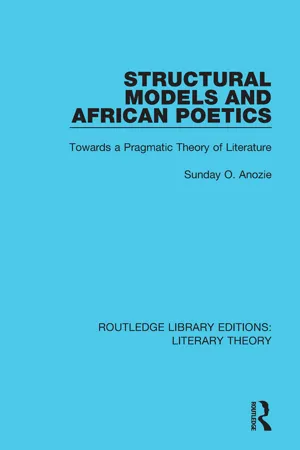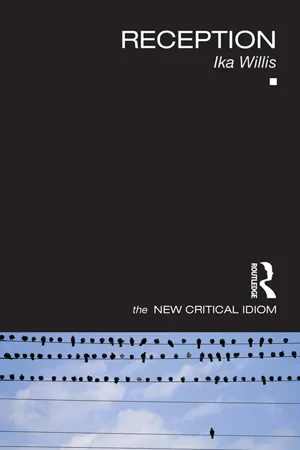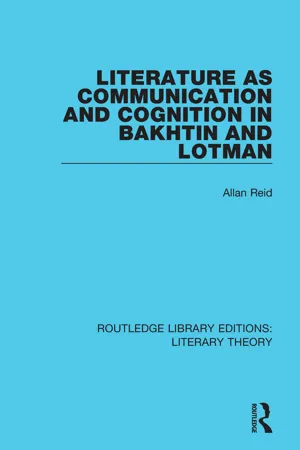Literature
Roman Jakobson
Roman Jakobson was a Russian-American linguist and literary theorist known for his work on structural linguistics and semiotics. He co-founded the Prague School of structural linguistics and made significant contributions to the study of language and literature, particularly in the areas of phonology, morphology, and poetics. Jakobson's theories have had a lasting impact on literary criticism and the understanding of language in literature.
Written by Perlego with AI-assistance
Related key terms
Related key terms
1 of 4
Related key terms
1 of 3
10 Key excerpts on "Roman Jakobson"
- eBook - ePub
Modern Criticism and Theory
A Reader
- Nigel Wood, David Lodge(Authors)
- 2014(Publication Date)
- Routledge(Publisher)
8 Roman Jakobson
DOI: 10.4324/9781315835488-8Introductory note
Roman Jakobson (1896–1982) was one of the most powerful minds in twentieth-century intellectual history, though general recognition of this fact came rather late in his long life. He was born in Russia and was a founder-member of the Moscow Linguistic Circle which played a major part in the development of Russian formalism. At this time, Jakobson was an enthusiastic supporter of the Russian futurist poets, and he never lost this commitment to modernist experiment and innovation. In 1920, he moved to Czechoslovakia and helped to found the Prague Linguistic Circle, which was the source of some of the important foundation work in structuralist linguistics and poetics. The Nazi invasion of Czechoslovakia in 1939 forced Jakobson to move on again, and in 1941 he arrived in the United States, where he lived until his death, teaching at Columbia, Harvard and MIT.Most of Jakobson’s published work consists of highly technical articles on matters of grammar and phonology, expecially in Slavonic languages. But he was able to apply his immense learning and speculative intelligence to theoretical questions of universal interest and importance, and to incisive linguistic analysis of classic literary texts in English and French. The French anthropologist Claude Lévi-Strauss, whose work gave such a powerful impetus to structuralism in the 1960s (see ‘Incest and Myth’, section 40 in 20th Century Literary Criticism), acknowledged his indebtedness to the linguistic theory of Roman Jakobson, and the two men collaborated on an analysis of Baudelaire’s poem ‘Les Chats’, published in the journal L’Homme in 1962, which acquired considerable fame, or notoriety, as a set piece of structuralist criticism (especially after Michael Riffaterre’s critique of it in Yale French Studies in 1966 ).Two ideas in Jakobson’s contribution to modern literary theory deserve special mention. One was his identification of the rhetorical figures, metaphor and metonymy, as models for two fundamental ways of organizing discourse that can be traced in every kind of cultural production. (See ‘The Metaphoric and Metonymic Poles’, reprinted below, pp. 165–68, an extract from ‘Two Aspects of Language and Two Types of Aphasic Disturbances’ in Jakobson and Morris Halle, Fundamentals of Language [1956].) The other was his attempt to understand ‘literariness’ – to define in linguistic terms what makes a verbal message a work of art. This was a preoccupation of the Russian formalists from the inception of the movement, but in ‘Linguistics and Poetics’, reprinted below, we find a lucid exposition of Jakobson’s mature thought on the subject, enlivened and illuminated by a staggering range of illustration. This paper was first delivered as a ‘Closing Statement’ to a conference on ‘Style in Language’ held at Indiana University in 1958, and is reprinted here from the proceedings of that conference, edited by Thomas Sebeok, and published under the title Style in Language - eBook - ePub
- Derek Attridge(Author)
- 2004(Publication Date)
- Routledge(Publisher)
A Prague School Reader; the most influential member of the group, apart from Jakobson, was Jan Mukarovský, many of whose works have been translated into English.2 A sympathetic summary of Jakobson’s linguistic theory, together with a bibliography of his output to 1976, can be found in Linda R. Waugh, Roman Jakobson’s Science of Language. A somewhat more detached view is taken in Elmar Holenstein, Roman Jakobson’s Approach to Language.His most influential pronouncement on the subject of the distinctiveness of literary language (which for Jakobson, as for Puttenham, primarily meant poetic language)3 was the paper “Linguistics and Poetics,” given as a closing statement to a conference on stylistics in 1958.4 Here Jakobson asserted that the “poetic function” entails a set (or “Einstellung”) not toward what he called the context of a message, not toward the addresser or addressee, not toward the code shared by the addresser and addressee or the contact that enables them to stay in communication, but toward the message as such. The poetic function is not peculiar to poetry, but in poetry it becomes dominant, constituting the defining feature, just as the other orientations, when they dominate, produce respectively the referential, emotive, conative, metalingual, and phatic functions (353-57).53 The inadequacy of Jakobson’s treatment of prose literature—which he regards as a “transitional linguistic area” between poetic and referential language—has often been commented upon; see, for instance, David Lodge, The Modes of Modern Writing, 91-92, and Mary Louise Pratt, Toward a Speech Act Theory - eBook - ePub
Language in Literature
Style and Foregrounding
- Geoffrey Leech(Author)
- 2014(Publication Date)
- Routledge(Publisher)
Stylistics and functionalism8.1 Roman Jakobson: a formalistic functionalist
In his admirable critique of Jakobson's 'Closing Statement' of the 1958 'Style in Language' conference, Derek Attridge1 has already discussed the model of linguistic functions presented by Jakobson in that memorable paper. The sections in which Jakobson discussed the functions of language also, naturally enough, form the pretext (or pre-text) for this chapter, which is on the theme of stylistics and functionalism.These two terms ‘stylistics’ and ‘functionalism’ I will define simplistically for the present purpose as follows: stylistics is the study of style (particularly in literary texts, and more particularly, with a view to explicating the relation between the form of the text and its potential for interpretation).2 Functionalism (in the study of language) is an approach which tries to explain language not only internally, in terms of its formal properties, but also externally, in terms of what language contributes to larger systems of which it is a part or subsystem. Whether we call these larger systems ‘cultures’, ‘social systems’, ‘belief systems’, etc. does not concern me. What is significant is that functionalist explanations look for relations between language and what is not language, whereas formalist explanations look for relations between the elements of linguistic text itself.It is commonly assumed, as I have just assumed, that functionalism is defined by contrast with its opposite, formalism. It is strange, then, that Jakobson, who provides us with one of the best-known classifications of language functions, should also, in his analyses of literary texts, be the most successful and influential practitioner of formalism. The basis of this paradox lies in Jakobson’s well-known definition of the poetic function as ‘the set (Einstellung ) towards the message itself, focus on the message for its own sake’ (Sebeok 1960: 356). It will be remembered that Jakobson’s typology of functions attributed a different function to each of the six components in an archetypal linguistic situation. Think of such a situation as one in which an ADDRESSER sends a linguistics MESSAGE to an ADDRESSEE - eBook - ePub
- Alastair Renfrew, Galin Tihanov(Authors)
- 2009(Publication Date)
- Routledge(Publisher)
This can be seen in the manner in which they are imbricated in their times, not merely as hapless victims of events, but as active players in the dramas of their age. Marcus Terentius Varro, whose Latin grammar became an instrument in the spread of the Roman empire (see Taylor 1974); Lorenzo Valla, whose fate became intertwined with that of Catholic theology when he demonstrated that the Donation of Constantine was a late forgery (see Wolff 1893); Lancelot Andrewes, a leading actor in the politics of Stuart England, and whose work on the King James Bible was to have momentous influence on a language that has now become a global lingua franca (see Nicolson 2003); or Wilhelm von Humboldt, whose work in founding the first modern research university, no less than a revolution in linguistics, was based on his vision as a philologist (see Quillen 1991). Jakobson’s work displays with unusual vividness a similar close connection to and concern with history. As had his illustrious predecessors, Jakobson helped to establish the provenance of some of the most important documents of Russian culture in his work on medieval texts, and especially on the Igor epic (collected in Jakobson 1966). His work on historical Czech grammar and research in the previously unsuspected riches of early Bohemian texts and Hussite hymnology were enormously influential for Czech literature. 7 Unlike many of the other great philologists, however, who quietly laboured in their studies, Jakobson the ebullient cosmopolitan had a personal as well as a scholarly impact in many different lands. He was a veritable Johnny Appleseed of linguistics, planting movements wherever he roamed - eBook - ePub
Semiotics and City Poetics
Jakobson's Theory and Praxis
- Mary Coghill(Author)
- 2022(Publication Date)
- De Gruyter Mouton(Publisher)
Chapter 1 What is Roman Jakobson’s “poetic function”?Roman Jakobson sums up his theory of poetic function as follows: “The poetic function projects the principle of equivalence from the axis of selection into the axis of combination” (1987: 71). Analysis of this important theory originates from within the Russian Formalist tradition of the importance of function as communication. Close examination of the terms of reference within Jakobson’s definition – “poetic function”, “equivalence” and “projection” – give rise to an understanding of the sense of movement inherent in Jakobson’s model which contributes to a semiotic structure. This is associated with iconicity and the interpretation of “similarity” in poetry. Jakobson’s early essay “Realism in Art” (1987 [1921]) demonstrates his engagement with modern art and provides the basis for the connections with the semiotic, the grammar of poetry. It is therefore argued that “poetic function”, within this definition, contains semiotic processes as well as linguistic ones. The importance of these semiotic characteristics is constantly highlighted and this demonstrates how they contribute to the construction of a city poetic genre. Analysis includes the use of linguistic, semiotic, structuralist, and stylistics methodology.In “On Realism in Art” (1987), Jakobson indicates not only that his interest in poetic theory had a strong foundation in the theory of art, but also that his own theory of “Poetic Function”, developed later in his life, was already in its earliest stages. He outlines the four different approaches to the analysis of painting which he later used to develop his methodology of poetic function. He looks for revolutionary realism in literature. He states that the words of “yesterday’s narrative grow stale” (1987: 22). The adherence to a so-called “realism” and verisimilitude by traditionalists fixes the response to the artwork, in a framework of analysing two criteria which are non-essential details. Briefly, Jakobson provides three categories, each of which have sub-categories of definition: - eBook - ePub
Structural Models and African Poetics
Towards a Pragmatic Theory of Literature
- Sunday O. Anozie(Author)
- 2016(Publication Date)
- Routledge(Publisher)
Barthes’s counterattack with Critique et vérit é (1966) portrayed Picard’s literary conservatism as a timid attempt to escape from the consequences of language and modern structuralism. The other example equally well-known is the Yale Professor, Michael Riffaterre’s muted but none the less angry critique of the methods and poetic theory of Jakobson. This attitude to which Robert Scholes approvingly alludes in his interestingly readable Structuralism in Literature (1964) — to Scholes, for example, it would seem that Riffaterre’s charge of ‘a fraudulent construction’ levelled against both Jakobson and Lévi-Strauss has a sound foundation and so is defensible (cf. ibid., pp. 32–9) — may well be based upon his notion of ‘super-reader’. This term indicates, in a pejorative sense, the type of monster who in Riffaterre’s view alone can display the capability and the powerful control of language required in order to be able to understand the intricate structures, say, of Baudelaire’s ‘Les Chats’ as displayed in the analysis by J Jakobson and Lévi-Strauss (cf. L’Homme, 1969). However, for our much more limited purpose in this chapter, the focus of interest will be on the dual question: (a) What is the nature of the correspondence which Jakobson established between verbal communication and poetic communication; and (b) what is the relevance of this correspondence to African poetics? To Jakobson all verbal communication can be reduced to a comprehensive schema of six factors, each factor having a different function. We cannot, Jakobson argues, engage in verbal communication of messages without utilizing one or more of these functions. Also, although the predominance of one function determines the verbal structure of our message, the six functions can exist in various hierarchical orders. A specific instance in which Jakobson’s schema can easily be applied is the traditional African drum - In the first half of the twentieth century, two parallel strands of critical thought were precursors to the emergence of reception and reader-response criticism in the 1960s–1980s. One, associated particularly with scholarship in Eastern Europe but also a small number of critics in the UK and US, insisted that it is not possible to understand a literary work without reference to a reader and the reading process. The other school of thought, increasingly dominant in the Anglophone world over this period, focussed on the literary work of art itself and, in some cases, explicitly ruled out reference to readers. Confusingly, the term ‘formalist’ has commonly been used to describe both traditions.In Eastern Europe from the 1910s to the 1930s, the interrelated critical schools known as the Russian Formalists and the Prague Structuralists began to investigate questions about literary language and meaning. The Russian Formalist critic and linguist Roman Jakobson argued throughout his career that literary and poetic effects could and must be analysed with the tools of linguistics. He stated in his book Modern Russian Poetry in 1921 that ‘the subject of literary scholarship is not literature … but literariness’ (cited in Erlich 1980: 172). In a 1958 essay, ‘Linguistics and Poetics’, he calls ‘literariness’ ‘the poetic function of language’, which is not confined to a particular subset of texts or utterances (poems); instead, it is one of six linguistic functions which, in varying proportions, may be seen to be present in all ‘verbal communication’ (Jakobson 1987 [1958]: 69). Thus, Jakobson claimed, ‘the poetic function of language … cannot be productively studied out of touch with the general problems of language’, while at the same time, ‘the scrutiny of language requires a thorough consideration of its poetic function’ (69). Ultimately, he concluded, citing John Hollander, ‘there seems to be no reason for trying to separate the literary from the overall linguistic’ (93).Meanwhile, the Prague structuralist Felix Vodička (1982 [1941]: 110) argued in 1941 in his essay ‘The Concretization of the Literary Work: Problems of the Reception of Neruda’s Works’ that the work of art is ‘a sign whose meaning and aesthetic value are comprehensible only on the basis of the literary conventions of a specific period’. A text has meaning only in relation to extratextual conventions, which determine the way in which it is read. The term Vodicˇka used in his title, ‘concretization’, was taken from the Polish philosopher Roman Ingarden (1974 [1931]: 252), who demonstrated in The Literary Work of Art
- eBook - ePub
Structuralist Poetics
Structuralism, Linguistics and the Study of Literature
- Jonathan Culler(Author)
- 2023(Publication Date)
- Routledge(Publisher)
1 then the linguist might contribute to literary studies by showing what properties of language were being exploited in particular texts and how they were extended or reorganized. The claim that this activity might be central to the study of literature is part of a general position shared by the Russian formalists, the Prague aestheticians, and contemporary structuralists; and the link between these groups – the man who has done more than anyone else to sustain this claim – is Roman Jakobson, whose theoretical statements and practical analyses are the basic texts of that variety of structuralism which seeks to apply the techniques of structural linguistics directly to the language of poems.Since literature is first of all language and since structuralism is a method based on linguistics, the most likely meeting place, as Genette observes, is that of the linguistic material itself (Figures, p. 149). The linguist might analyse the phonological, syntactic, and semantic structures of sentences in poems, but it would be left to the critic to analyse the special functions this linguistic material acquires when it is organized as a poem. Jakobson insists, however, that such restrictions on the role of linguistics ‘are based on an outmoded prejudice which either takes away from linguistics its fundamental aim, that is to say the study of the verbal form in relation to its functions, or else cedes to linguistic analysis only one of the diverse functions of language: the referential function’ (Questions de poétique, p. 485). All instances of language fulfil at least one of the six functions: the referential, the emotive, the phatic, the conative, the metalingual and the poetic. And the linguist cannot neglect one of these six if he would achieve a comprehensive theory of language. Indeed, for Jakobson poetics is an integral part of linguistics and can be defined as ‘the linguistic study of the poetic function in the context of verbal messages in general and in poetry in particular’ (ibid., - Allan Reid(Author)
- 2016(Publication Date)
- Routledge(Publisher)
Poetics Today 1, 3 (1980), 7-25.61. As far as I know there is no definitive biography of Jakobson to date, although I have not tried overly hard to locate one, but there are many briefer references concerning his life and work. For a small sample of the esteem in which he was and is held by his peers see A Tribute to Roman Jakobson. 1896-1982 . (Berlin, New York, Amsterdam: Mouton, 1983). There have also, of course, been numerous Festschriften and collections of articles including, e.g. Roman Jakobson: Echoes of His Scholarship , ed. Daniel Armstrong and C.H. van Schooneveld, (Lisse: The Peter de Ridder Press, 1977), and Roman Jakobson, Verbal Art. Verbal Sign. Verbal Time , ed. Krystyna Pomorska and Stephen Rudy, (Minneapolis: University of •Minnesota Press, 1985).62. Cf. Krystyna Pomorska and Stephen Rudy, Preface to Verbal Art. Verbal Sign. Verbal Time ,: "Roman Jakobson . .. ranks among the seminal thinkers who shaped the 'human sciences' in the twentieth century." vii.63. Cf. Ibid., viii, C.H, van Schooneveld, "By Way of Introduction: Roman Jakobson's Tenets and Their Potential," in Roman Jakobson. 1, and Roman Jakobson, ' ." in Poetics-poetvka-poètika. (Warsaw: Panstwowe Wydawnictwo Naukowe; Gravenhage: Mouton & Co.'S, 1961), 397-417.64. Jakobson. 30.65. Jakobson, "What is Poetry?" in Semiotics of Art . 174.66. See especially Jakobson, "Linguistics and Poetics," in Style in Language , ed. Thomas Sebeok, (New York: John Wiley, 1960), 350-77.67. Cf. "Linguistics and Communication Theory," in Selected Writings. II, (The Hague: Mouton, 1971), 570-571.1 am speculating about the causal relationship, but it seems probable.68. See also Jakobson, "The Dominant," and Linda R. Waugh, "The Poetic Function and the Nature of Language," in Verbal Art, Verbal Sign, Verbal Time , 143-168.69. And cybernetics. I have in mind such fundamental notions and terms as sender, receiver, message, medium, code, channel, and so on, A comparison of Jakobson's model with Shannon and Weaver's is very suggestive, although I am not aware of any studies in which the two models are confronted. Cf. Warren Weaver, "Recent Contributions to the Mathematical Theory of Communication," in Claude E. Shannon and Warren Weaver, The Mathematical Theory of Communication- eBook - ePub
On the Subject of English
The Linguistics of Language Use and Learning
- Henry Widdowson(Author)
- 2019(Publication Date)
- De Gruyter Mouton(Publisher)
form, its linguistic wording, and not its content. This distinction between message content and form is not only crucial to an understanding of what Jakobson is proposing, but, as we shall see, central to the general question of the relationship between pragmatic and poetic creativity. For if creativity is to equated with the poetic function in this Jakobsonian sense, it follows that it will come about whenever there is a focus on the form of a particular message, whatever its content. One might note, in passing, that such a conclusion is not likely to be welcome in SLA circles where focus on form is seen as counter-productive and responsible for deflecting focus away from meaning, and arresting the natural process of language acquisition. How can it be, one might wonder, that a focus on form can be commended as essentially creative on the one hand, and condemned as essentially uncreative on the other? This is, surely, a question worth pondering.But Jakobson has more to say about the poetic function. He goes on to suggest how this focusing on form is brought about: “The poetic function projects the principle of equivalence from the axis of selection into the axis of combination” (Jakobson 1960 : 358).This perhaps calls for a little elucidation. Linguistic elements at any level (sounds, words, grammatical constituents, phrases) are paradigmatically classified by their equal potentiality of occurrence in a syntagmatic combination. Thus, to take a simple example, all words that can occur as adjectives in the noun phrase the … sea are equivalent in that any one that is selected would complete the grammatical combination:, the deep sea, the salt sea, the cruel sea and so on. If more than one is selected over and above syntactic requirement, this equivalence is then projected into the axis of combination and the poetic function realized: the deep, salt, cruel sea. This principle, simple enough in itself, can of course result in complex patterns when it operates across linguistic levels, as in the combination of recurrent sounds, words and phrases in this quotation from Dylan Thomas’s Under Milk Wood
Index pages curate the most relevant extracts from our library of academic textbooks. They’ve been created using an in-house natural language model (NLM), each adding context and meaning to key research topics.
Explore more topic indexes
Explore more topic indexes
1 of 6
Explore more topic indexes
1 of 4
